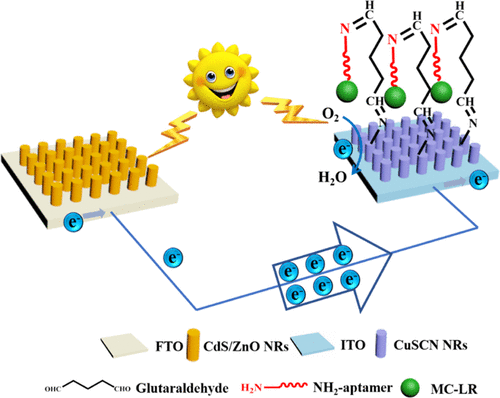当前位置:
X-MOL 学术
›
Anal. Chem.
›
论文详情
Our official English website, www.x-mol.net, welcomes your feedback! (Note: you will need to create a separate account there.)
Novel Anti-Interference Strategy for a Self-Powered Sensor: Mediator-Free and Biospecific Photocathode Interface
Analytical Chemistry ( IF 7.4 ) Pub Date : 2021-09-10 , DOI: 10.1021/acs.analchem.1c02555 Jie Wei 1 , Qinqin Hu 1 , Yun Gao 1 , Nan Hao 1 , Jing Qian 1 , Kun Wang 1
Analytical Chemistry ( IF 7.4 ) Pub Date : 2021-09-10 , DOI: 10.1021/acs.analchem.1c02555 Jie Wei 1 , Qinqin Hu 1 , Yun Gao 1 , Nan Hao 1 , Jing Qian 1 , Kun Wang 1
Affiliation

|
As a new electrochemical sensing concept, a self-powered sensor shows a good application prospect in the field of analysis. However, it is still a great challenge to improve the anti-interference capability of sensors through reasonable design. In this study, we investigated the difference between the single photoanode and photocathode self-powered sensor and combined the advantages of these two aspects to fabricate a mediator-free self-powered aptasensor based on the dual-photoelectrode system, which combined the biological events from the photocathode. The biological events occurred at the photocathode could avoid the interference caused by the generated hole oxidation of reducing small molecules in the real sample on the photoanode surface, which was helpful to enhance the anti-interference capability of the sensor. Moreover, due to the sufficient Fermi level differentiation between two photoelectrodes, the redox mediator was not necessary. This could avoid the redox reaction caused by the introduction of extra electron donors or electron acceptors occurring before the photoelectrical behavior, thus improving the accuracy of the sensor. According to the influence of the generated biological conjugate on the external circuit, electron transmission between interfaces, and the obstruction of visible light irradiation, the sensitive and accurate detection of the analytical model was achieved. This work provided a proof-of-concept for the establishment of a mediator-free dual-photoelectrode self-powered sensing platform with high sensitivity and strong anti-interference performance.
中文翻译:

自供电传感器的新型抗干扰策略:无介质和生物特异性光电阴极接口
自供电传感器作为一种新的电化学传感概念,在分析领域显示出良好的应用前景。然而,通过合理的设计来提高传感器的抗干扰能力仍然是一个很大的挑战。在这项研究中,我们研究了单光电阳极和光电阴极自供电传感器之间的差异,并结合这两个方面的优点,制造了一种基于双光电极系统的无介质自供电适体传感器,结合了来自光电阴极。光电阴极发生的生物事件可以避免光电阳极表面真实样品中还原性小分子产生空穴氧化产生的干扰,有助于增强传感器的抗干扰能力。而且,由于两个光电极之间有足够的费米能级差异,氧化还原介质不是必需的。这可以避免在光电行为之前引入额外的电子供体或电子受体引起的氧化还原反应,从而提高传感器的精度。根据生成的生物共轭物对外电路、界面间电子传输和可见光照射受阻的影响,实现了对解析模型的灵敏准确检测。该工作为建立具有高灵敏度和强抗干扰性能的无介质双光电极自供电传感平台提供了概念验证。氧化还原介体不是必需的。这可以避免在光电行为之前引入额外的电子供体或电子受体引起的氧化还原反应,从而提高传感器的精度。根据生成的生物共轭物对外电路、界面间电子传输和可见光照射受阻的影响,实现了对解析模型的灵敏准确检测。该工作为建立具有高灵敏度和强抗干扰性能的无介质双光电极自供电传感平台提供了概念验证。氧化还原介体不是必需的。这可以避免在光电行为之前引入额外的电子供体或电子受体引起的氧化还原反应,从而提高传感器的精度。根据生成的生物共轭物对外电路、界面间电子传输和可见光照射受阻的影响,实现了对解析模型的灵敏准确检测。该工作为建立具有高灵敏度和强抗干扰性能的无介质双光电极自供电传感平台提供了概念验证。从而提高传感器的精度。根据生成的生物共轭物对外电路、界面间电子传输和可见光照射受阻的影响,实现了对解析模型的灵敏准确检测。该工作为建立具有高灵敏度和强抗干扰性能的无介质双光电极自供电传感平台提供了概念验证。从而提高传感器的精度。根据生成的生物共轭物对外电路、界面间电子传输和可见光照射受阻的影响,实现了对解析模型的灵敏准确检测。该工作为建立具有高灵敏度和强抗干扰性能的无介质双光电极自供电传感平台提供了概念验证。
更新日期:2021-09-21
中文翻译:

自供电传感器的新型抗干扰策略:无介质和生物特异性光电阴极接口
自供电传感器作为一种新的电化学传感概念,在分析领域显示出良好的应用前景。然而,通过合理的设计来提高传感器的抗干扰能力仍然是一个很大的挑战。在这项研究中,我们研究了单光电阳极和光电阴极自供电传感器之间的差异,并结合这两个方面的优点,制造了一种基于双光电极系统的无介质自供电适体传感器,结合了来自光电阴极。光电阴极发生的生物事件可以避免光电阳极表面真实样品中还原性小分子产生空穴氧化产生的干扰,有助于增强传感器的抗干扰能力。而且,由于两个光电极之间有足够的费米能级差异,氧化还原介质不是必需的。这可以避免在光电行为之前引入额外的电子供体或电子受体引起的氧化还原反应,从而提高传感器的精度。根据生成的生物共轭物对外电路、界面间电子传输和可见光照射受阻的影响,实现了对解析模型的灵敏准确检测。该工作为建立具有高灵敏度和强抗干扰性能的无介质双光电极自供电传感平台提供了概念验证。氧化还原介体不是必需的。这可以避免在光电行为之前引入额外的电子供体或电子受体引起的氧化还原反应,从而提高传感器的精度。根据生成的生物共轭物对外电路、界面间电子传输和可见光照射受阻的影响,实现了对解析模型的灵敏准确检测。该工作为建立具有高灵敏度和强抗干扰性能的无介质双光电极自供电传感平台提供了概念验证。氧化还原介体不是必需的。这可以避免在光电行为之前引入额外的电子供体或电子受体引起的氧化还原反应,从而提高传感器的精度。根据生成的生物共轭物对外电路、界面间电子传输和可见光照射受阻的影响,实现了对解析模型的灵敏准确检测。该工作为建立具有高灵敏度和强抗干扰性能的无介质双光电极自供电传感平台提供了概念验证。从而提高传感器的精度。根据生成的生物共轭物对外电路、界面间电子传输和可见光照射受阻的影响,实现了对解析模型的灵敏准确检测。该工作为建立具有高灵敏度和强抗干扰性能的无介质双光电极自供电传感平台提供了概念验证。从而提高传感器的精度。根据生成的生物共轭物对外电路、界面间电子传输和可见光照射受阻的影响,实现了对解析模型的灵敏准确检测。该工作为建立具有高灵敏度和强抗干扰性能的无介质双光电极自供电传感平台提供了概念验证。



























 京公网安备 11010802027423号
京公网安备 11010802027423号